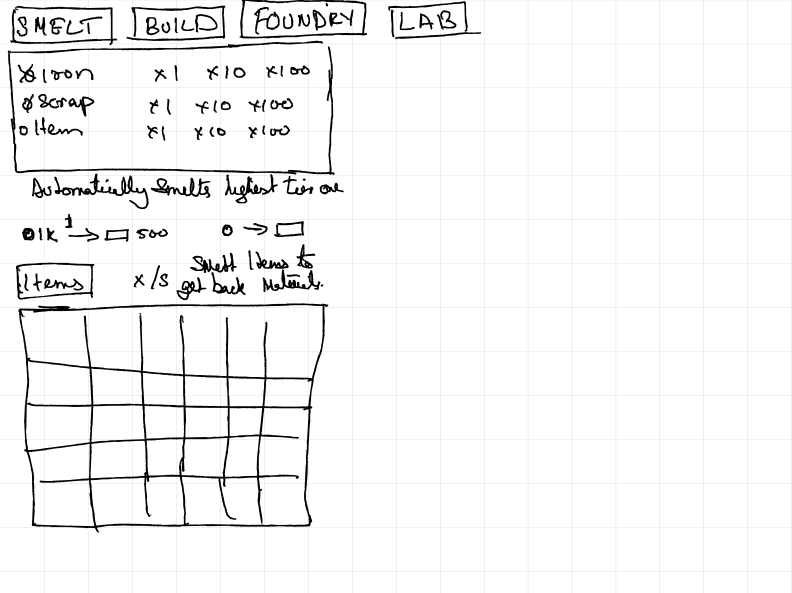Materials
Endeavour: triangle
This post relates to triangle , an arcade, ARPG, factory game I’m working on.
In triangle, everything should feel earned - so all items are crafted, not found. I am also a big fan of factory / automation games. How much of a factory sim can we squeeze into an ARPG (or on to a triangle for that matter)? Let’s find out!
Drops
As a starting point, when asteroids are destroyed, they will drop materials. I’ve also been pondering whether materials could drop when they split. It makes logical sense, but I want to get a better sense of pacing before diving into that question.
Currently, only iron drops. I started off by finding a sprite sheet with reasonable looking sprites and then started integrating them in before I decided to just stick with shapes — so iron drops are little blue circles.
| |
PS: you haven’t seen the Shape code, but you get the gist.
These drops are managed by a MaterialField that keeps track of all the dropped
materials. They are given a low linear velocity, and no rotational velocity
(it’s a circle, so you wouldn’t see it anyway).
They do not interact with collisions to avoid them being bumped off the screen or you having to chase them down.
At some point, they could also be optimised to only update if they are on screen. Assuming the player will pick up most of them, this may not be necessary.
Pickup
I also “installed an attractor” on the ship such that if it gets close enough to a material, it’ll pull it in. When it’s close enough, it’ll be “picked up.”
| |
It is a physics interaction, so it is possible to slingshot the material and have it fly off the screen (it’s happened to me). It feels like a sun interaction and you are in control of it, so I am inclined to leave that in.
Once it’s close enough, it’s picked up, and added to an inventory.
The attractor also feels like an upgrade that can be crafted later.
Smelting
Crafting Panel
For smelting, I started by sketching out a straightforward UI. I’ll admit up front that I don’t enjoy UI work, but in earnest I started on it, and I got as far as displaying the panel itself and I got tremendously bored.

I decided to make material refinement prioritisation automatic, at least for the time being. It would always prioritise the most valuable material that is in the inventory.
Actually, that’ll remove some factory micromanagement without removing the feeling of agency from the player.
It’ll mainly be a problem if the player has run out of lower tier materials and they have a large amount of higher tier items in the inventory. I figure let’s wait until we have some playtesting before we worry about it. The system currently only drops one material and it can be refined automatically.
Refining
All materials and items will have a tier, starting with iron at 1. To be able to smelt a material, you’ll need a smelter at a minimum of that tier. For example to craft iron, you need a minimum tier 1 smelter (which is fine since 1 is the minimum tier anyway). If you wanted to smelt a tier 3 material, you’ll need a minimum of tier 3 smelter.
The ship starts with a Tier 1 smelter and will always have a tier 1 smelter. This smelter cannot be modified, removed, or destroyed. The same is true of some other factories, which will be covered in the next post.
The first iteration of refining took the total capacity of all smelters at each
tier, and would convert a portion of the materials from ore to ingot. It
used floating points to track progress. If it would take four seconds to convert
one ore to ingot, over one second, it’d transfer 0.25 from ore to ingot.
The display only showed integers, so there was a bit of floor and ceil to be
able to show consistent numbers.
I didn’t like this way of doing things. It felt icky — hacky — but it was simple enough and it works, for now.